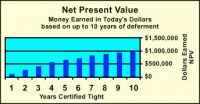Postpone API 653 inspections with annual integrity testing by Mass Technology Corporation.
 Example of Earned Income Due to Deferment of API 653 10 Year Inspection.
Example of Earned Income Due to Deferment of API 653 10 Year Inspection.
Deferring your API 653 tank entry and inspection with a tightness certification from Mass Technology Corporation can reduce your expenses, avoid the environmental impact caused by tank entry and clean-out, prevent tank bottom damage caused by tank entry, and reduce your tank out of service time. These are all factors that can save you real dollars. Entering a tank that can be verified tight is not something that any operator wants to do. Entry not only does not ensure tightness, but also can cause tight tanks to leak.
Some AST operators underestimate the need for leak detection. If the aboveground tank is supported on cradles or the tank installed in a vault any leaks should be readily detected. The onground tank is something else altogether. The most likely location of a leak is the least accessible, the tank bottom. Damage from corrosion can occur on both the inside and the underside, allowing product to escape under the tank. In large volume tanks this cannot be detected by inventory control. Although the total quantity leaked may be significant, the amount lost each day will be so small as to be undetectable through inventory control measures. A leak rate as low as one gallon per hour in a tank as small as 50,000 gallons is only 0.002 percent of the tank volume, but this rate will release over 700 gallons in one month. Some positive monitoring for leak detection is very important with onground AST tanks.
Leak detection for AST is much more difficult than UST’s. The effects of temperature on the volume of liquid in the tank as it is warmed during the day and expands, cause the contents level to rise. The reverse happens at night as the temperature drops, this makes level measurement a poor choice for detecting small product losses.
Mass measurement is not influenced by change in product volume due to temperature.
The most important reason to use mass rather than level/volume measurement is the expansion of the product in the tank due to temperature change is not a factor. The factor is different for each type of product, API 30 crude oil changes volume by about 0.045 % for each degree change in temperature near 60 degrees. In a 100 ft. diameter tank, this would result in an apparent leak of 529 gallons for one degree of temperature change or 22 gallons per hour if the one-degree change occurred over a 24-hour test. The magnitude of this error makes compensation for it particularly difficult. This error would have to be estimated based on predicted expansion factors rather than measured, if level measurement were used.
The mass of the product in a tank can be measured by measuring the fluid’s hydrostatic head. The head measurement is a precise measure of the total mass inside the tank when the head is multiplied by the average surface of the tank (average over all heights from zero to the height of the fluid). For the purpose of leak detection a change in mass is being measured so the average surface area does not need to be known to any great precision. A change in hydrostatic head during the course of the leak test is the principal parameter measured. The tank is blinded during the test to eliminate errors due to valve leaks.
In a 100 ft. diameter tank containing a product of specific gravity of one, a one gallon loss in fluid will result in a head loss of 1.7/100,000 foot (about 0.2 mils). The ability to measure that one gallon would require measurement 5000 times more precise than custody transfer requirements of +/- 0.1 inch. The resolution achieved by Mass Technology’s transducers is 0.1 PPM or 3/1,000,000 foot (0.04 mils).
Sensitivity verified by third party evaluation.
With the sensitivity of Mass Technology’s transducers and the ability to compensate for the factors that could cause errors in the measurement, Mass Technology is able to detect leaks in a 100 ft. diameter tank as small as 0.64 GPH. The 0.64 GPH detection threshold was determined by third party evaluation of the Mass Technology system. Copies of the evaluation report are available by contacting Mass Technology.

